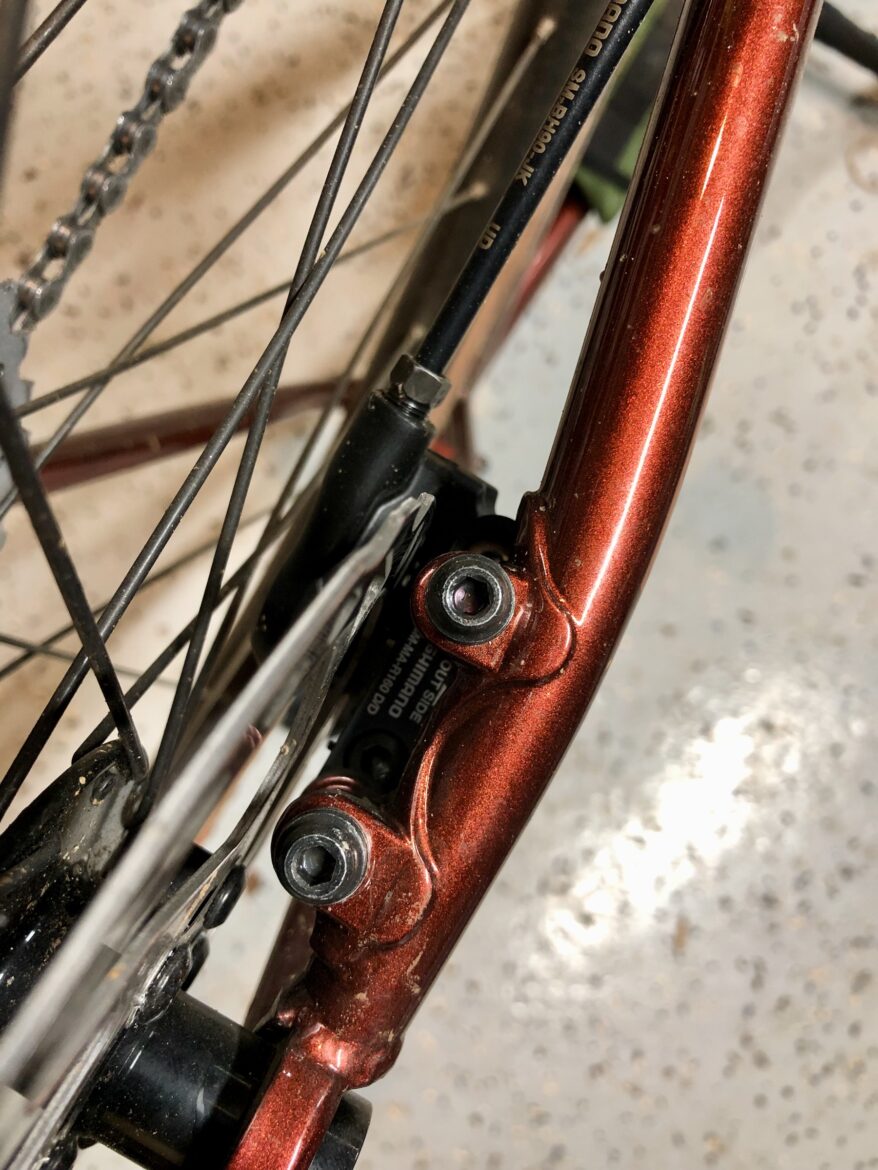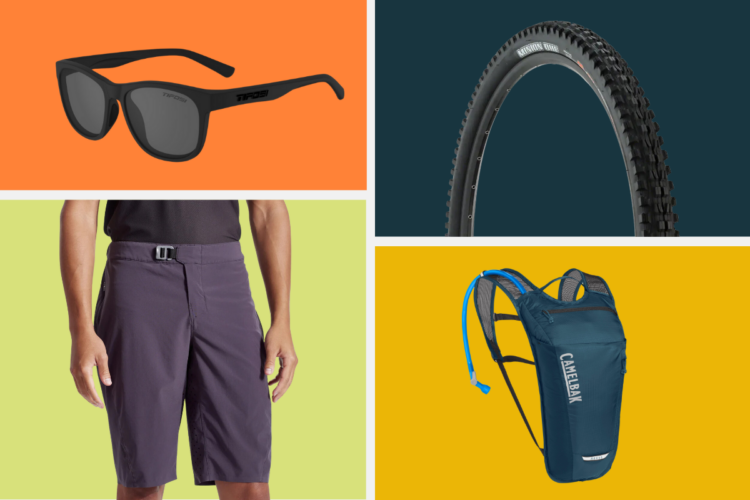
For those of us who have been riding for a long time, the rise of dedicated gravel bike gear seemed odd, at least at first. Why? Mountain bikes are perfectly capable of riding on gravel roads! Road bikes, less so, but hey, throw on some fatter, knobbier tires and let’s roll. Looking at the Shimano GRX groupset, however, it’s clear that gravel riding sits in between mountain biking and road cycling, and deserves its own set of well thought out components.
I’ve been shifting and squeezing the Shimano GRX group for hundreds of miles this winter on a Jamis Renegade steel gravel bike. As a dedicated mountain biker, many parts of the system feel familiar — like hydraulic disc brakes and one-by shifting — yet it’s also a very gravel-specific experience. Here’s what I’ve learned about what’s the same — and different — compared to Shimano mountain bike groups. I’ll also provide my own MTB-focused recommendations for putting together your own GRX group.

Shimano GRX drivetrain
Mountain bikers familiar with the 11-speed Shimano XT rear derailleur will notice many similarities to the 800-series GRX derailleur. Both feature Shadow RD+ shifting action, a clutch for minimizing chain slap, and similar installation, adjustment, and operation. The biggest change GRX brings is a “gravel-tuned clutch tension” that’s presumably dialed for the vibrations — but not necessarily big hits — associated with gravel riding. A less expensive, 400-series GRX derailleur is also available, appearing similar to an SLX-level derailleur.
The other difference is the GRX derailleurs aren’t designed to fit larger, MTB-sized cassettes. The largest cassette the RD-RX812 derailleur I’m testing will fit is 11-42T, compared to the 11-speed XT derailleur that will work with cassettes up to 11-46T. Another GRX derailleur — the RD-RX810 — is even shorter, fitting a max 34T cassette ring, which most will choose to run as part of a two-by setup.
Speaking of the cassette, Shimano doesn’t offer gravel-specific choices, at least not explicitly. Yet. For now, buyers can choose from various 11-speed Shimano road and mountain bike cassettes to complete the drivetrain. For mountain bikers who have an 11-speed cassette sitting on a shelf in the garage, this is the perfect time to dust it off! My setup uses a Sunrace 11-42 cassette and it’s proven to work flawlessly with the GRX system.

Similarly, Shimano doesn’t offer a GRX-specific 11-speed chain, and recommends one of their 11-speed road bike chains to complete the group. My build is running a KMC X-Series 11-speed chain, and again, any 11-speed chain will work, including mountain chains. I’ve found the KMC chain shifts quickly and smoothly on the Sunrace cassette.
While mountain biking has gone almost 100% one-by when it comes to cranksets, there’s still a good argument to be made for having two rings up front for gravel riding, especially on the top end for pedaling flat roads. Shimano offers a GRX front derailleur and dual ring crankset in the 11-speed line, though I’m testing a one-by configuration. As a mountain biker, I’m pretty much one-by for life now, even if it means occasionally falling behind on group rides.

The Shimano GRX crankset officially weighs 644g for the 40T version I’ve been testing, which is significantly less than an 11-speed, XT crankset. The other main difference, besides the ability to run larger chainrings, is a narrower Q-factor than Shimano mountain cranksets. Pulling the pedals slightly closer toward the center of the bike generally makes pedaling more comfortable, and I find it’s welcome on longer rides.
At the shifting end, the Shimano GRX group looks much more road bike-ready, but having experience with dedicated road shifters, these feel a bit chunkier and more mountain bike-y to me. Part of it could be from the clutched derailleur; in my experience the whole system has a very Shimano feel to it with decisive shifts and rugged operation. More to the point, it’s exactly what I want from a gravel shifter. Road bike gear, while lightweight and sleek, just doesn’t lend the same level of confidence when you’re abusing the drivetrain through rocks and roots.
There are a number of choices when it comes to the shifters, which double as brake levers, depending on whether your drivetrain is one- or two-by, and if you’re running a dropper post. Yes, there’s a set of left controls that serve as a dropper post remote, and even if your gravel bike doesn’t have a dropper post (yet), I recommend spending the few extra bucks for the set with a dropper remote. The ST-RX810-LA shifter looks just like the other versions, but with a hidden lever for dropping your post. Like the one-by drivetrain, I’m also a dropper post fan for life, even on drop bar gravel bikes.

Shimano GRX brakes
While road bikes slowly moved into disc brakes, gravel bikes have mostly had them from the start, and many skip the mechanicals for full-on hydraulic power. My setup is no different, with two-piston, RX-400 hydraulic disc brakes. Shimano doesn’t offer a four-piston GRX brake, and there probably isn’t the need for one. The two-piston brakes are surprisingly powerful, and besides, skinny gravel tires lose traction much more easily than wide, grippy mountain bike tires so there isn’t much of a point to having more power if you’re going to end up in a skid, not to mention, most people aren’t matching the downhill speeds of their gravel bike to their mountain bikes.
Shimano also offers a GRX, flat-bar style set of brake levers for those who prefer riding on top of the bars in certain situations — for example cyclocross — and want the added confidence of braking out of the drops. The hoods on the drop bar versions have a great hand position though and make it easy and ergonomic to grab the brakes while on top of the drops. The hoods also feel a bit more angular and squarish than the ones I’m used to on road bikes.


While Shimano mountain bike brakes attach via bolts from the top, the GRX brakes are attached from the bottom, either to the frame or an adapter. I suppose this makes for a cleaner look, but it does complicate installation and servicing a bit. On the rear brake, one of the mount bolts features a clip similar to the one used on the pad retention bolt, likely in a bid to ensure the brakes stay attached through notoriously buzzy gravel road vibrations.

Like mountain bike brakes, the pads are top loading and buyers can choose from metal or resin compounds. GRX uses the same pads as many XT and SLX brake sets so again, many mountain bikers may already have some laying around. Finned, ICE Tech pads are available as well.
Home mechanics will also be stoked that the GRX brakes use mineral oil and promise an easy-bleed design. Mechanical brake fans will need to look elsewhere, as all of the GRX brake levers are hydraulic.

When it comes to rotors, once again riders have plenty of choices. Most gravel bikes will have smaller rotors than modern mountain bikes, so if you have some 140mm or 160mm rotors on the shelf they should fit the bill. My setup is running SM-RT66, 160mm rotors front and back, notable for their 6-bolt attachment and lack Centerlock compatibility. It’s nice to see how adaptable the whole GRX group is, with the ability to mix and match components from different manufacturers so riders aren’t locked into, say, running gravel-specific rotors and chains.
Bottom line: The Shimano GRX groupset offers some nice design tweaks of their proven mountain and road bike groups, with a decidedly reliable and rugged feel. For mountain bikers who have been riding a while, putting together a GRX group for a gravel bike could be as easy as picking up a brake/shifter set, crankset, and rear derailleur and piecing together the rest with spare parts. And now that mountain biking has moved on to 12-speed, picking up 11-speed parts is cheaper than ever before.
- Price: About $300-400 per side for shifter/brake combo; $60-120 derailleur; $150-250 crankset
- Buy from JensonUSA and REI.
Party laps
- Good feel and reliable for rough riding
- Compatibility with many familiar and available mountain bike parts
- Gravel-specific features where they count
Pros and cons of the Shimano GRX drivetrain and brake group set.
Dirt naps
- A confusing array of choices for those buying a la carte among available shifter/brake combos
- No mechanical brake option for those who want to avoid the hassles of hydraulics









